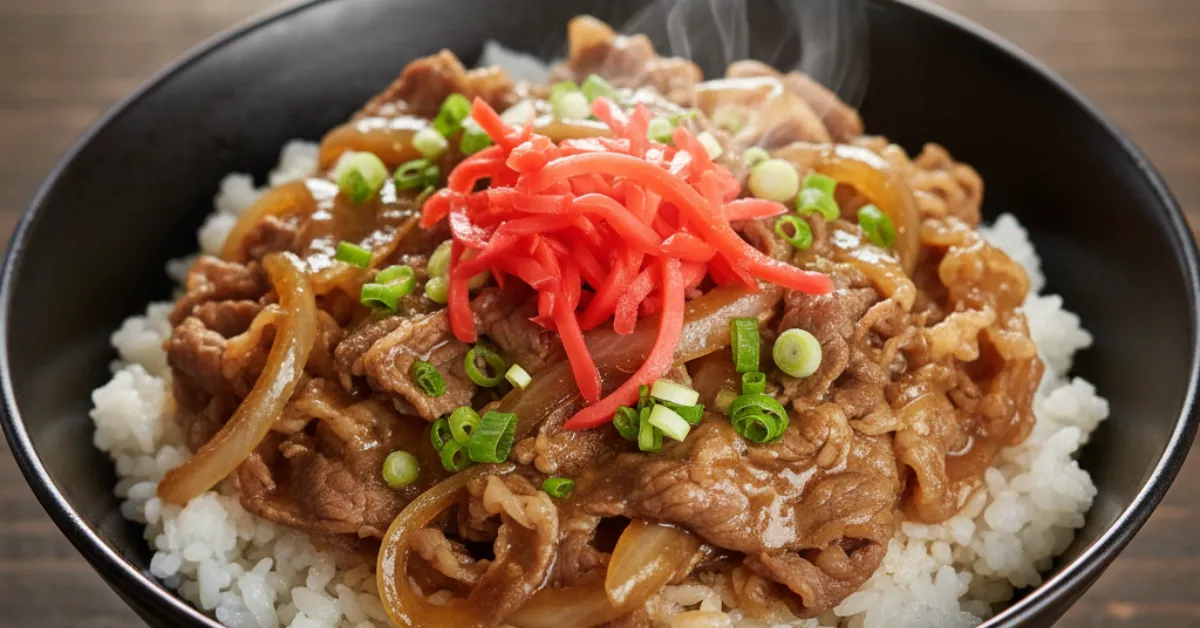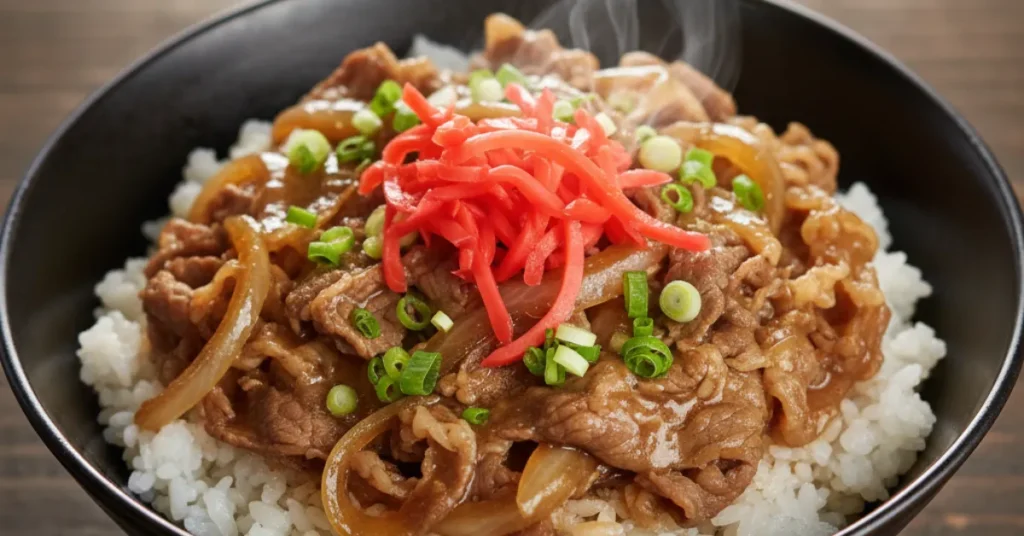
I see you there, staring longingly at the takeout menu. Don’t even think about it! You’re about to discover a secret: the most addictive, savory, umami-rich Japanese comfort food—the legendary Gyūdon—is ridiculously easy to make at home.
Why pay $15 for a bowl when you can make a better-than-Yoshinoya **gyudon recipe** for pennies? Seriously, this dish is the definition of Japanese fast food done right: thinly sliced beef and sweet onions, all tenderly simmered in a savory-sweet broth, piled high over fluffy rice. It’s heaven in a bowl, and it’s about to be your new weeknight obsession.
Get ready to be teased: once you smell this simmering, you won’t be able to wait for the first bite. It’s simple, quick, and perfectly balanced. Let’s make the best **beef gyudon recipe** you’ve ever tasted!
- Why You’ll Love This Recipe
- Ingredients
- Instructions
- You Must Know
- Storage Tips
- Ingredient Substitutions and Variations
- Serving Suggestions
- Cultural and Historical Notes
- Seasonal Adaptations
- Three Helpful Notes about This Recipe
- Success Stories
- Freezer Meal Conversion
- Pro Tips
- Common Recipe Questions
- What You’ll Need
- Steps to Follow
- Extra Handy Tips
- Tools You’ll Need
- Allergy Details
Why You’ll Love This Recipe
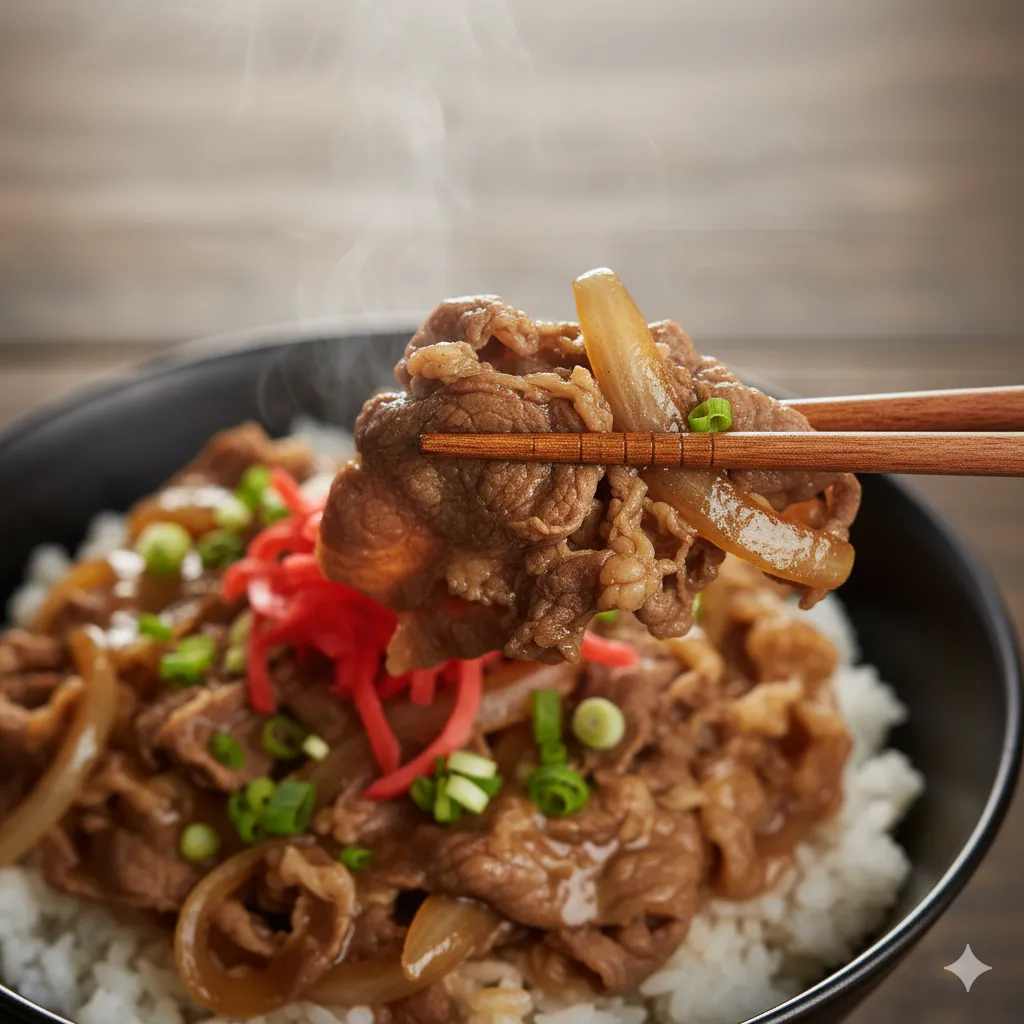
- **Authentic Japanese Flavor:** This is a true **gyudon recipe japanese** cooks would approve of, using essential ingredients like dashi, mirin, and sake for rich umami depth.
- **Lightning Fast:** From start to finish, this dish is ready in 30 minutes or less. It’s faster than delivery!
- **Budget-Friendly:** You only need a small amount of beef to feed the whole family since it’s served over filling rice.
- **Unbeatable Comfort:** It’s the ultimate “donburi” (rice bowl) experience—warm, savory, and deeply satisfying.
Ingredients
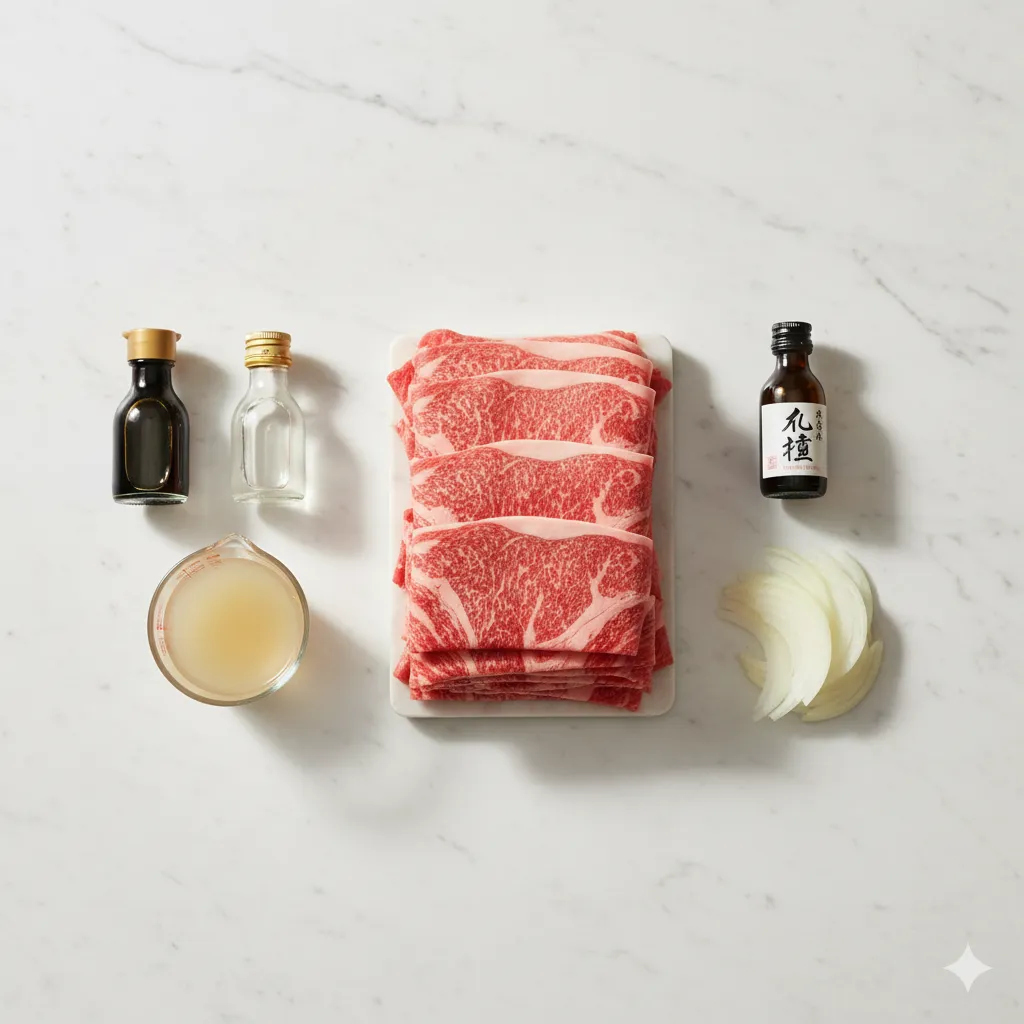
The magic of this **gyudon recipe** lies in the sauce, which is a perfect balance of four elements—sweetness, saltiness, umami, and a hint of acidity. Do not skip the traditional Japanese seasonings; they are what gives this dish its signature taste.
- **The Beef:** Thinly sliced beef (shaved ribeye or chuck is ideal). It must be thin to cook instantly and soak up the sauce.
- **The Onion:** Yellow or white onion, thinly sliced, which adds a crucial layer of sweetness as it simmers.
- **The Broth (Dashi):** Japanese dashi stock (easily made from powder or granules) is the flavor base.
- **The Seasonings:** Soy sauce (shoyu), mirin (sweet rice wine), and sake (cooking wine). A pinch of sugar helps achieve that perfect caramel glaze.
- **The Toppings:** Steamed white rice, chopped green onions, and pickled red ginger (beni shoga).
Instructions
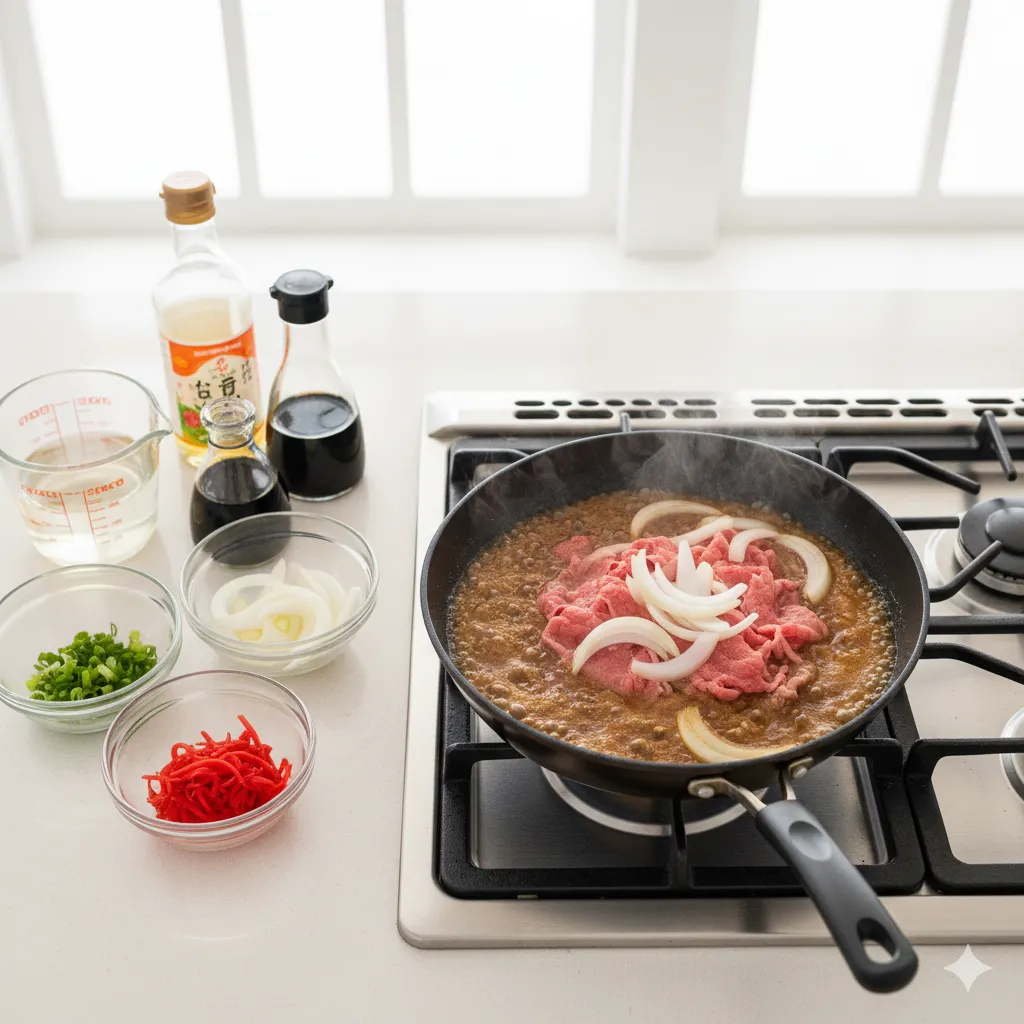
1. Prepare the Sauce:
In a wide, shallow pot or deep skillet, combine the dashi, soy sauce, mirin, and sake. Add the sugar and bring the mixture to a gentle boil over medium-high heat. You are creating the foundation for your delicious **gyudon recipe**.
2. Simmer the Onions:
Add the thinly sliced onions to the simmering broth. Reduce the heat to medium-low and allow the onions to cook for 5 to 7 minutes, or until they are soft and translucent. This step is essential as it sweetens the onions and allows them to absorb the sauce flavor before the beef goes in.
3. Cook the Beef:
Once the onions are soft, add the thinly sliced beef. The key is to add the beef in loose, separate layers—do not dump it all in a big clump! You want the beef to cook very quickly, only taking about 2 to 3 minutes. Stir gently to ensure all the beef is submerged and cooked through. The meat should remain tender and pink should disappear almost instantly.
4. Assemble and Serve:
Ladle a generous amount of steamed white rice into deep serving bowls. Using tongs or a slotted spoon, carefully arrange the saucy beef and onions over the rice. Pour a small amount of the remaining savory broth over the meat and rice. Garnish with a sprinkle of fresh green onions and a scoop of pickled red ginger. Serve immediately! This is how you make the ultimate **gyūdon** experience at home.
You Must Know
Achieving the perfect, tender beef in this **gyudon recipe** is the make-or-break element. The beef must be sliced paper-thin—ideally, less than 1/8 inch. If you cannot find pre-sliced beef labeled for Shabu-Shabu or Sukiyaki at an Asian market, buy a cut of chuck or ribeye and freeze it for about 30 to 45 minutes. Partially frozen beef is much firmer and easier to slice extremely thinly against the grain using a sharp knife. When adding the beef to the simmering sauce, make sure the heat is low enough that the liquid is just barely bubbling. If you drop the beef into a rolling boil, it will seize up, become tough, and lose its ability to soak up the sauce, resulting in chewy, dry meat. This is particularly important for any **beef gyudon recipe** where the meat is briefly simmered rather than seared. Another crucial component is the rice. Use a good quality, short-grain Japanese rice and ensure it is perfectly cooked and slightly sticky to absorb the sauce from the meat without becoming mushy. The traditional accompaniment, *beni shoga* (pickled ginger), provides the necessary bright, tangy contrast to the rich, savory beef. Do not skip this topping; it cuts through the richness and cleanses the palate, elevating the entire experience. Many seek to **how to make yoshinoya beef bowl gyudon recipe** at home, and the secret is truly in the balance of the sauce ingredients—dashi for foundation, sake for fragrance, mirin for sweetness, and soy sauce for saltiness.
Storage Tips
Gyūdon is truly best eaten immediately, but if you have leftovers of the cooked beef and onion mixture, store them in an airtight container in the refrigerator for up to 3 days. Store leftover rice separately. When reheating, place the beef and sauce in a small saucepan and gently bring it back to a simmer over low heat. Reheat the rice in a microwave or steamer. Do not reheat the beef mixture multiple times, as it will make the thin slices tough.
Ingredient Substitutions and Variations
If you cannot find dashi, you can substitute it with low-sodium chicken broth, though it will slightly alter the traditional umami flavor. If you do not have sake, simply omit it, or replace it with an extra teaspoon of mirin for sweetness. For a spicier twist, add a dash of *ichimi* (Japanese chili flakes) or Sriracha to the sauce. You can also prepare a **rice cooker gyudon** by simply combining the sauce ingredients in the rice cooker with the rice (use slightly less liquid than usual) and adding the beef during the last 5 minutes of the cooking cycle. Traditionally, gyūdon is sometimes served topped with a raw egg yolk or a soft-boiled onsen tamago, which adds richness and creaminess to the entire bowl—a must-try for any adventurous eater!
Serving Suggestions
Gyūdon is a complete meal, but it is often served with a small bowl of miso soup and a light side salad dressed with a simple sesame dressing. The contrasting flavors of the soup and salad help refresh the palate between bites of the rich, savory **beef gyudon recipe**. A sprinkle of *shichimi togarashi* (Japanese seven-spice blend) over the finished bowl adds color and a pleasant warmth.
Cultural and Historical Notes
Gyūdon, meaning “beef bowl,” is one of Japan’s most famous *donburi* (rice bowl) dishes and a staple of Japanese quick-service restaurants, particularly chains like Yoshinoya and Sukiya. Its popularity soared in the late 19th and early 20th centuries as beef consumption became more common in Japan. It is celebrated as fast, cheap, and deeply satisfying comfort food. The simplicity and speed of this **gyudon recipe** reflect its history as a quick, yet nourishing, meal for busy people, cementing its place as an iconic element of Japanese food culture.
Seasonal Adaptations
While gyūdon is typically a year-round comfort dish, you can slightly adapt the vegetables. In the summer, you might top it with quick-pickled cucumbers for extra crunch and coolness. In the cooler months, thinly sliced shiitake mushrooms can be simmered along with the onions to add an earthy depth to the traditional **gyudon recipe** sauce.
Three Helpful Notes about This Recipe
- **Slice Beef Thinly:** This is the absolute most important step. If you can’t find pre-shaved beef, partially freeze a cut of chuck or ribeye for 30 minutes before slicing.
- **Do Not Boil the Beef:** Add the beef to a *barely* simmering sauce and cook for only 2-3 minutes. Overcooking will result in tough, dry meat.
- **Use Pickled Ginger:** The bright, tangy flavor of *beni shoga* (red pickled ginger) is essential for cutting through the savory richness of the sauce.
Success Stories
This is often the first Japanese recipe people master at home! I frequently hear from readers who say they’ve stopped going to their local Japanese beef bowl chain because this homemade **gyudon recipe** is simply better and costs less. Many people who searched for **how to cook yoshinoya beef** found this recipe to be the closest authentic version they’ve tried outside of Japan, noting the perfect balance of the sweet and salty sauce.
Freezer Meal Conversion
Since the cooking time is already so short, freezing is not highly recommended for the assembled dish. However, you can make a large batch of the simmering sauce (dashi, soy sauce, mirin, sake) and freeze it in portions for up to 3 months. When ready to cook, thaw the sauce, bring it to a simmer, add the fresh onions and beef, and you have instant gyūdon! Always cook the beef and rice fresh.
Pro Tips
- For extra richness, top your finished bowl with a raw egg yolk or a quickly poached egg (onsen tamago).
- For deep umami flavor, use a tablespoon of oyster sauce or a small amount of dried kelp (*kombu*) when simmering the onions.
- To ensure perfect rice for your **gyudon recipe**, wash the rice thoroughly until the water runs clear before cooking.
Common Recipe Questions
gyudon recipe japanese
An authentic **gyudon recipe japanese** style involves thinly sliced beef and onions simmered quickly in a sauce made primarily of dashi, soy sauce, mirin, and sake, then served over a bowl of steamed white rice.
beef gyudon recipe
The best **beef gyudon recipe** uses shaved or paper-thin slices of beef (usually chuck or ribeye), which allows the meat to cook almost instantly and become incredibly tender while absorbing the savory-sweet sauce.
how to make yoshinoya beef bowl gyudon recipe
To **how to make yoshinoya beef bowl gyudon recipe** at home, focus on a high-quality dashi stock base and a perfectly balanced sauce of soy sauce, mirin, and sake. The key is to simmer the onions first, then cook the beef briefly in a barely simmering liquid.
rice cooker gyudon
A simple **rice cooker gyudon** can be achieved by cooking the beef mixture separately and topping the fresh rice, or by adding the pre-simmered onions and sauce ingredients to the rice cooker (using slightly less water) and adding the beef during the last few minutes of the cooking cycle.
gyudon recipes
**Gyudon recipes** are versatile and can be made with various cuts of beef, but the core elements remain the same: thin beef, sweet onions, savory-sweet simmering sauce, and a base of short-grain white rice.
What You’ll Need
→ The Beef & Onion
1 lb thinly sliced beef (shaved ribeye or chuck)
1 medium yellow onion, thinly sliced
→ The Sauce
1 cup dashi stock
1/4 cup soy sauce
1/4 cup mirin
2 tbsp sake (optional)
1 tbsp granulated sugar
→ For Serving
4 cups cooked short-grain white rice
Chopped green onions
Pickled red ginger (*beni shoga*)
→ Tools
Wide, shallow pot or deep skillet
Measuring cups and spoons
Steps to Follow
- Combine dashi, soy sauce, mirin, sake, and sugar in a pot; bring to a simmer.
- Add sliced onions and simmer over medium-low heat until soft (5-7 minutes).
- Add beef in loose layers and simmer for only 2-3 minutes until cooked through.
- Ladle rice into bowls, top generously with the beef and onion mixture, and drizzle with sauce.
- Garnish and serve immediately.
Extra Handy Tips
If the sauce reduces too much, add a splash of water or dashi to keep the simmering liquid slightly soupy.
If you don’t have pickled red ginger (*beni shoga*), a dash of spicy chili oil can add a different but equally welcome counterpoint to the richness.
Slicing the onion very thin helps it melt into the sauce and distribute its sweetness perfectly.
Tools You’ll Need
- Wide, shallow pot or deep skillet
- Tongs or slotted spoon
- Rice cooker or saucepan for rice
Allergy Details
This **gyudon recipe** contains soy (soy sauce). It is naturally dairy-free and gluten-free if using Tamari or gluten-free soy sauce, and verifying the dashi. It is important to verify ingredient labels and consult a healthcare professional if you have allergies.

